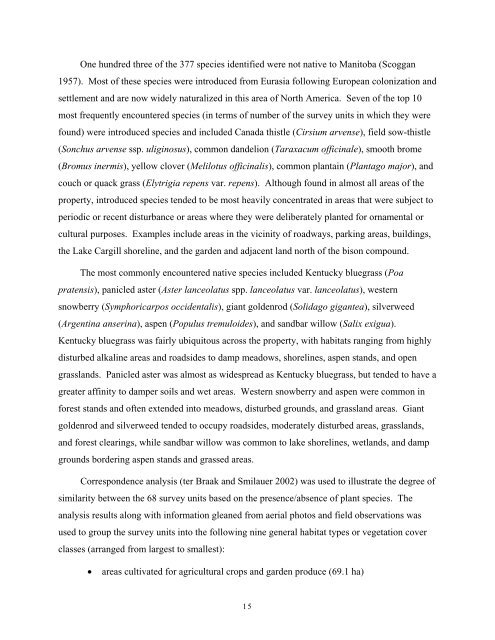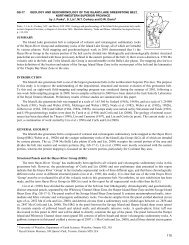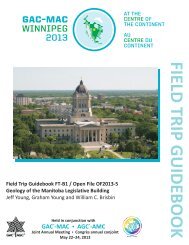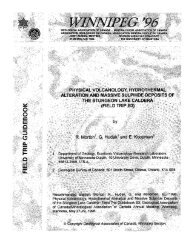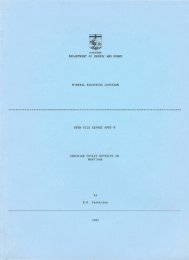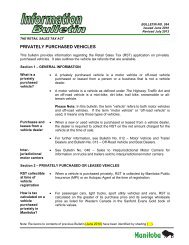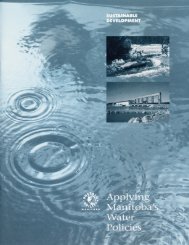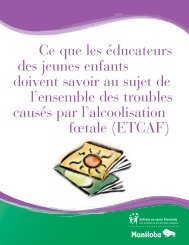Vegetation and Soil Monitoring at Flin Flon, Manitoba
Vegetation and Soil Monitoring at Flin Flon, Manitoba
Vegetation and Soil Monitoring at Flin Flon, Manitoba
You also want an ePaper? Increase the reach of your titles
YUMPU automatically turns print PDFs into web optimized ePapers that Google loves.
One hundred three of the 377 species identified were not n<strong>at</strong>ive to <strong>Manitoba</strong> (Scoggan<br />
1957). Most of these species were introduced from Eurasia following European coloniz<strong>at</strong>ion <strong>and</strong><br />
settlement <strong>and</strong> are now widely n<strong>at</strong>uralized in this area of North America. Seven of the top 10<br />
most frequently encountered species (in terms of number of the survey units in which they were<br />
found) were introduced species <strong>and</strong> included Canada thistle (Cirsium arvense), field sow-thistle<br />
(Sonchus arvense ssp. uliginosus), common d<strong>and</strong>elion (Taraxacum officinale), smooth brome<br />
(Bromus inermis), yellow clover (Melilotus officinalis), common plantain (Plantago major), <strong>and</strong><br />
couch or quack grass (Elytrigia repens var. repens). Although found in almost all areas of the<br />
property, introduced species tended to be most heavily concentr<strong>at</strong>ed in areas th<strong>at</strong> were subject to<br />
periodic or recent disturbance or areas where they were deliber<strong>at</strong>ely planted for ornamental or<br />
cultural purposes. Examples include areas in the vicinity of roadways, parking areas, buildings,<br />
the Lake Cargill shoreline, <strong>and</strong> the garden <strong>and</strong> adjacent l<strong>and</strong> north of the bison compound.<br />
The most commonly encountered n<strong>at</strong>ive species included Kentucky bluegrass (Poa<br />
pr<strong>at</strong>ensis), panicled aster (Aster lanceol<strong>at</strong>us spp. lanceol<strong>at</strong>us var. lanceol<strong>at</strong>us), western<br />
snowberry (Symphoricarpos occidentalis), giant goldenrod (Solidago gigantea), silverweed<br />
(Argentina anserina), aspen (Populus tremuloides), <strong>and</strong> s<strong>and</strong>bar willow (Salix exigua).<br />
Kentucky bluegrass was fairly ubiquitous across the property, with habit<strong>at</strong>s ranging from highly<br />
disturbed alkaline areas <strong>and</strong> roadsides to damp meadows, shorelines, aspen st<strong>and</strong>s, <strong>and</strong> open<br />
grassl<strong>and</strong>s. Panicled aster was almost as widespread as Kentucky bluegrass, but tended to have a<br />
gre<strong>at</strong>er affinity to damper soils <strong>and</strong> wet areas. Western snowberry <strong>and</strong> aspen were common in<br />
forest st<strong>and</strong>s <strong>and</strong> often extended into meadows, disturbed grounds, <strong>and</strong> grassl<strong>and</strong> areas. Giant<br />
goldenrod <strong>and</strong> silverweed tended to occupy roadsides, moder<strong>at</strong>ely disturbed areas, grassl<strong>and</strong>s,<br />
<strong>and</strong> forest clearings, while s<strong>and</strong>bar willow was common to lake shorelines, wetl<strong>and</strong>s, <strong>and</strong> damp<br />
grounds bordering aspen st<strong>and</strong>s <strong>and</strong> grassed areas.<br />
Correspondence analysis (ter Braak <strong>and</strong> Smilauer 2002) was used to illustr<strong>at</strong>e the degree of<br />
similarity between the 68 survey units based on the presence/absence of plant species. The<br />
analysis results along with inform<strong>at</strong>ion gleaned from aerial photos <strong>and</strong> field observ<strong>at</strong>ions was<br />
used to group the survey units into the following nine general habit<strong>at</strong> types or veget<strong>at</strong>ion cover<br />
classes (arranged from largest to smallest):<br />
• areas cultiv<strong>at</strong>ed for agricultural crops <strong>and</strong> garden produce (69.1 ha)<br />
15


